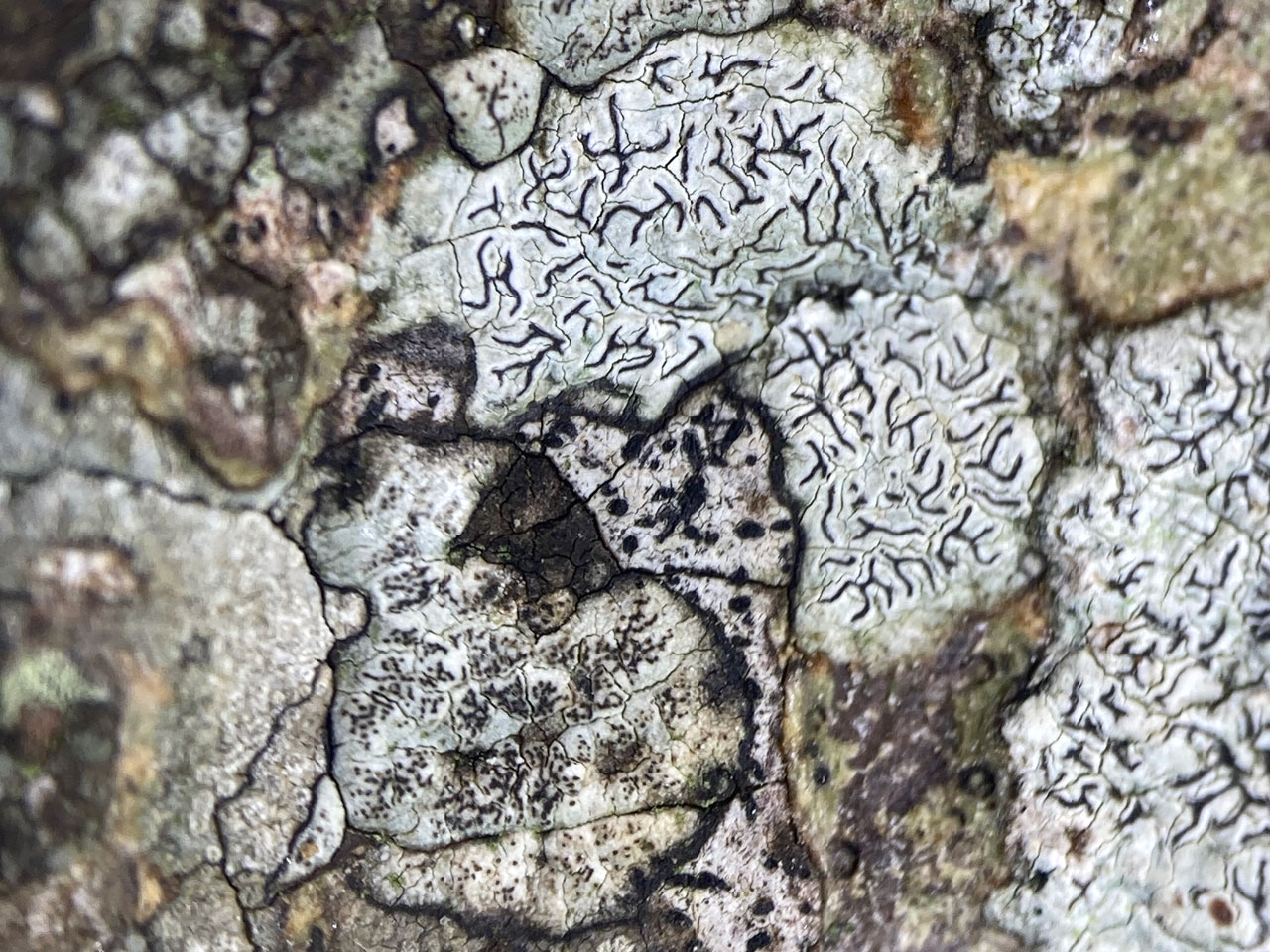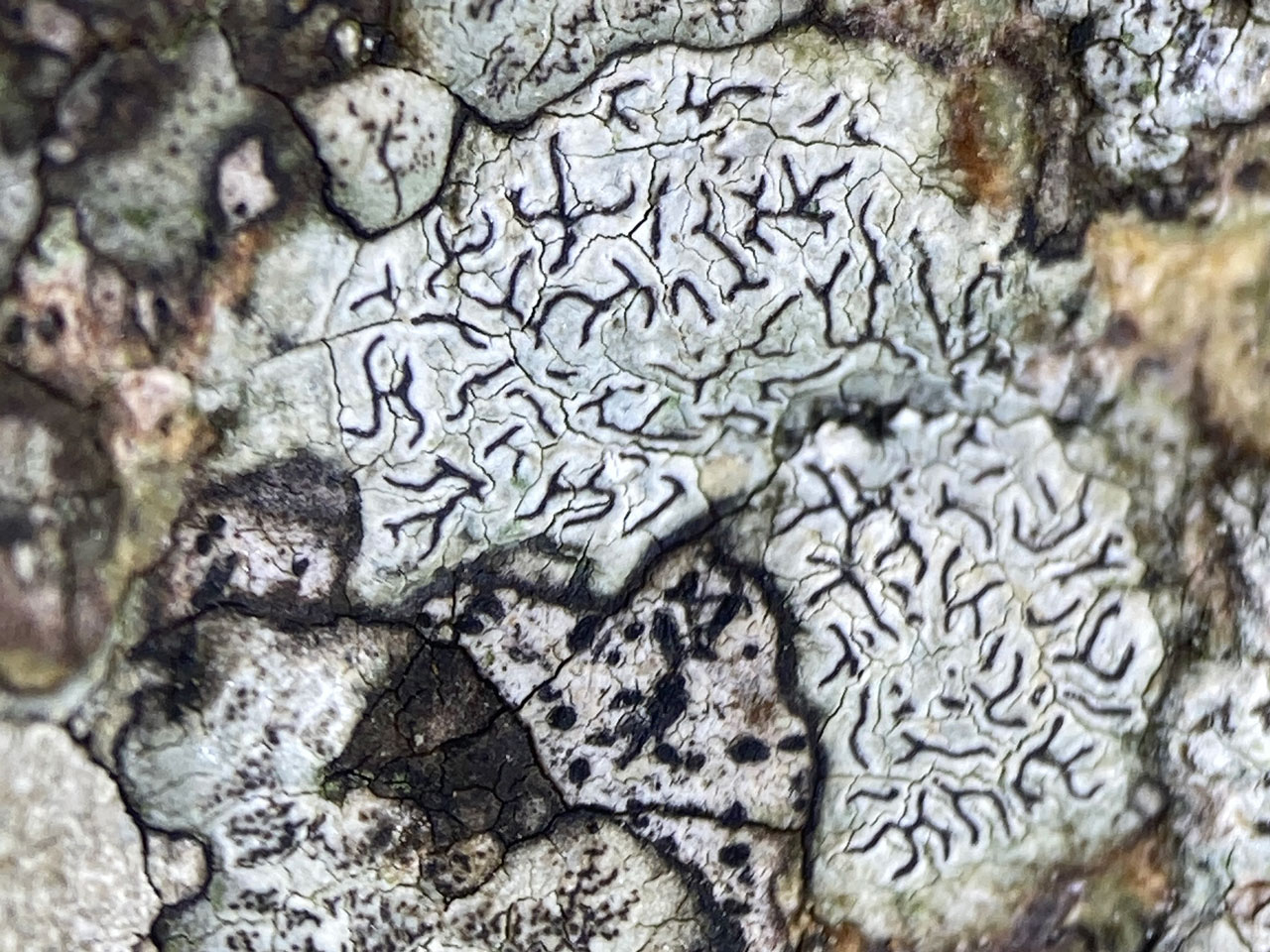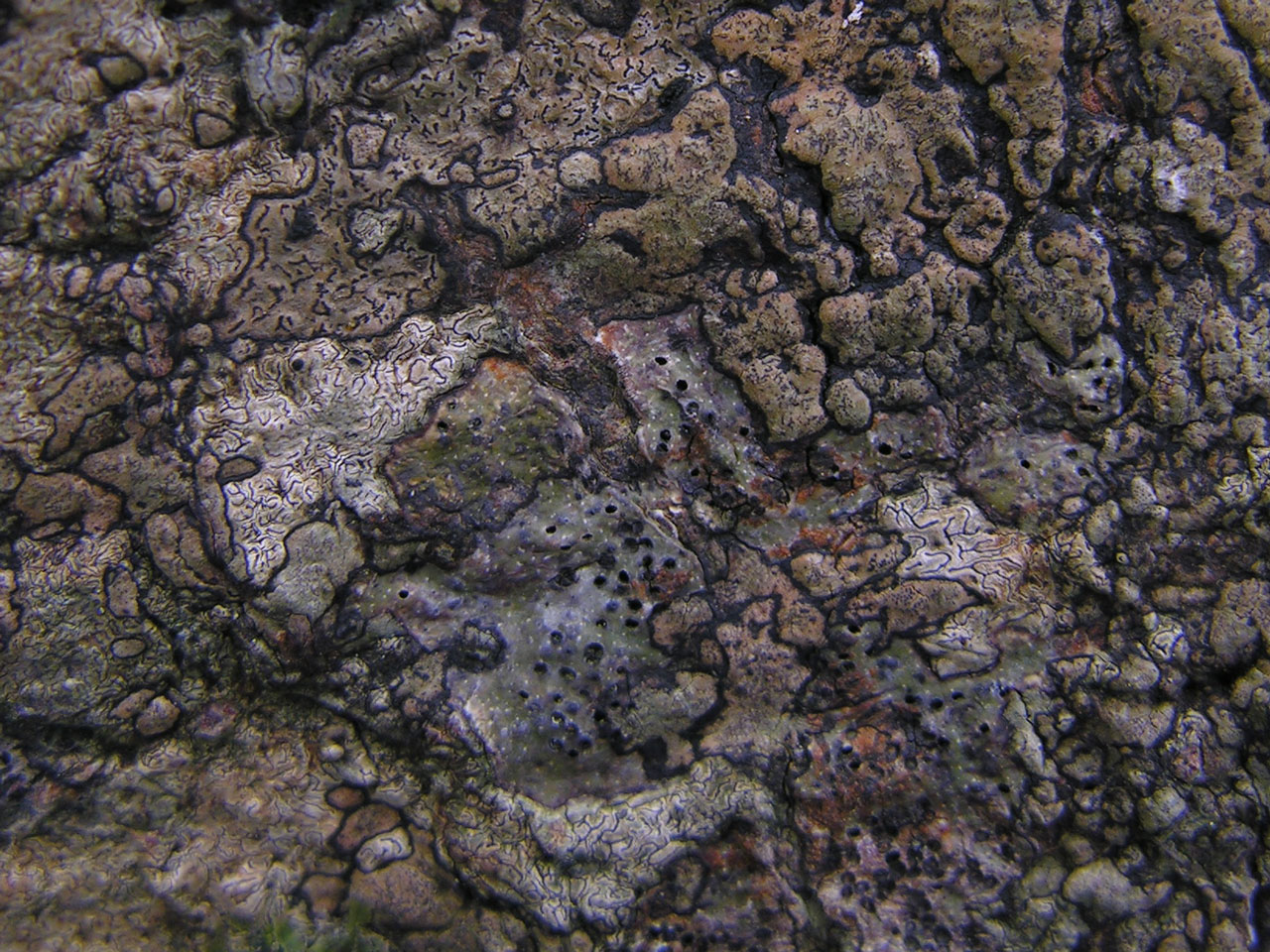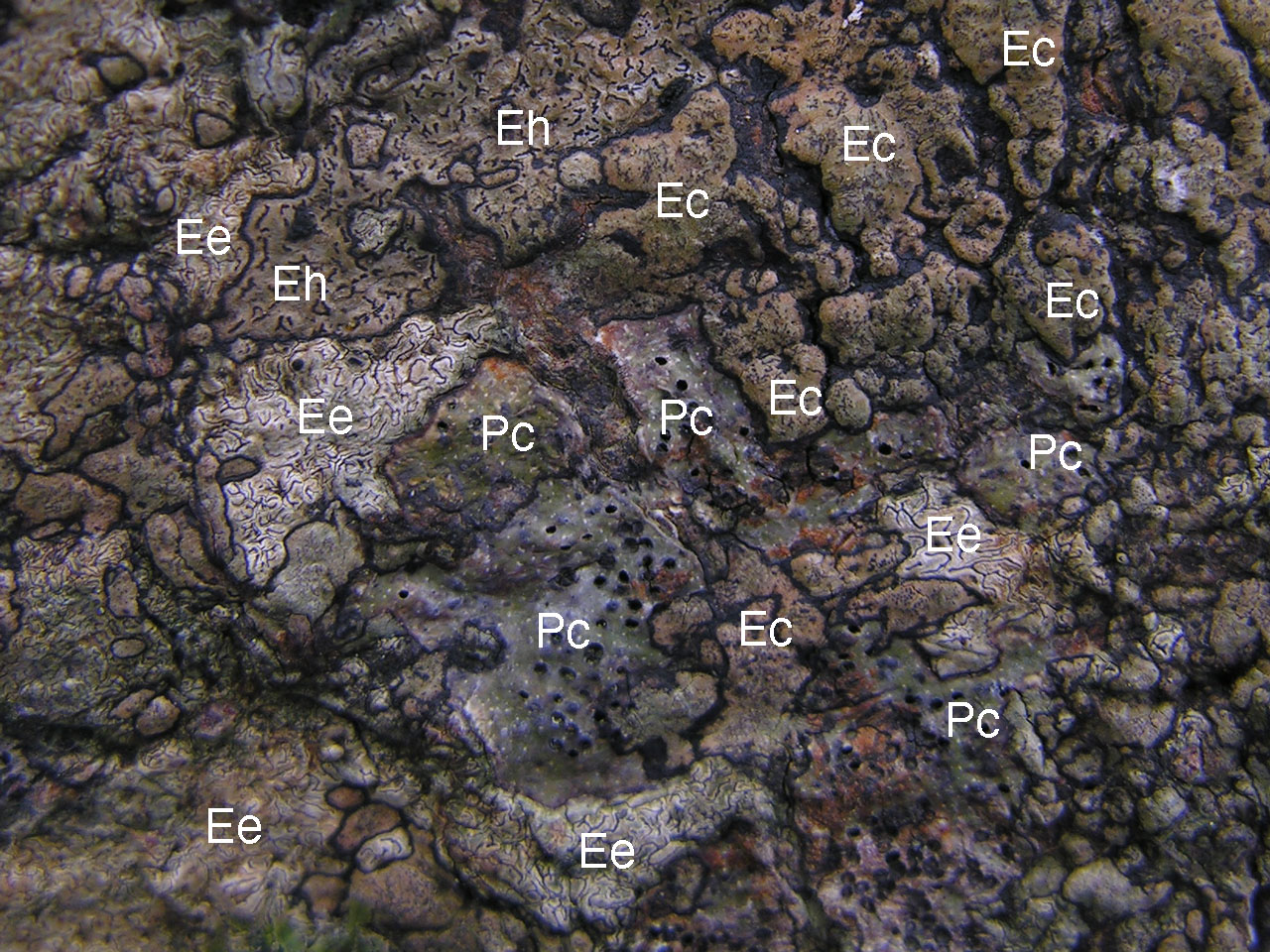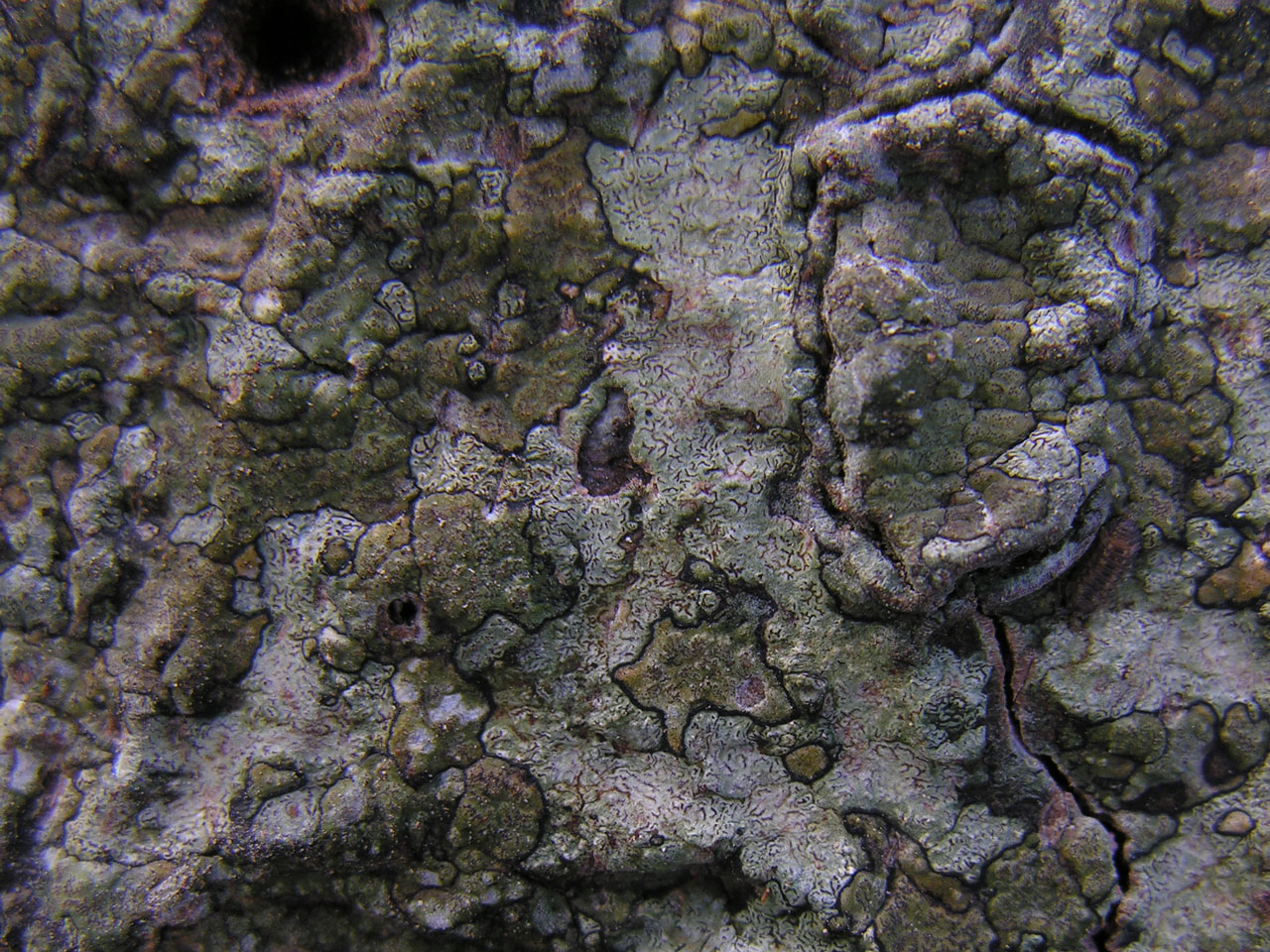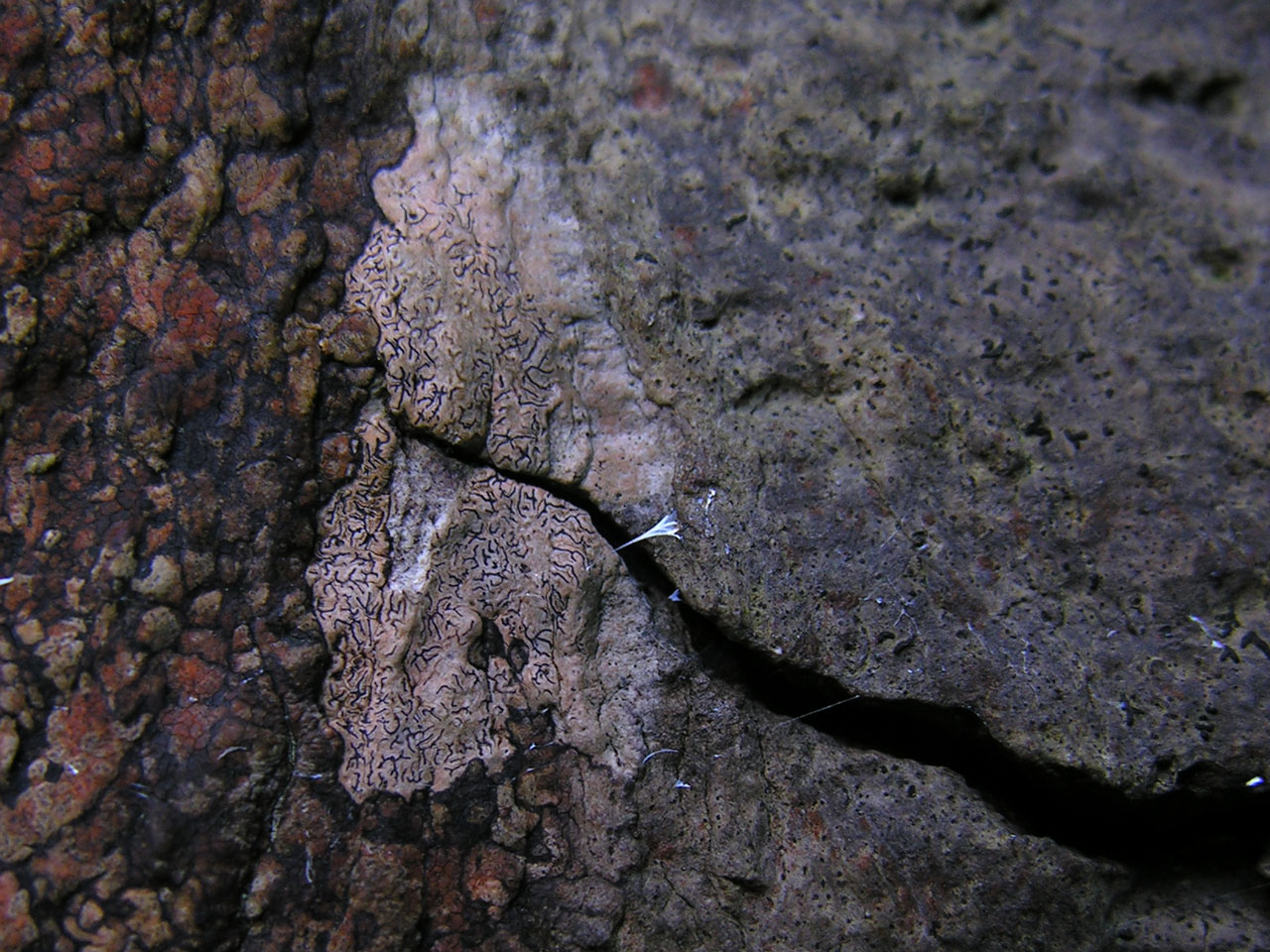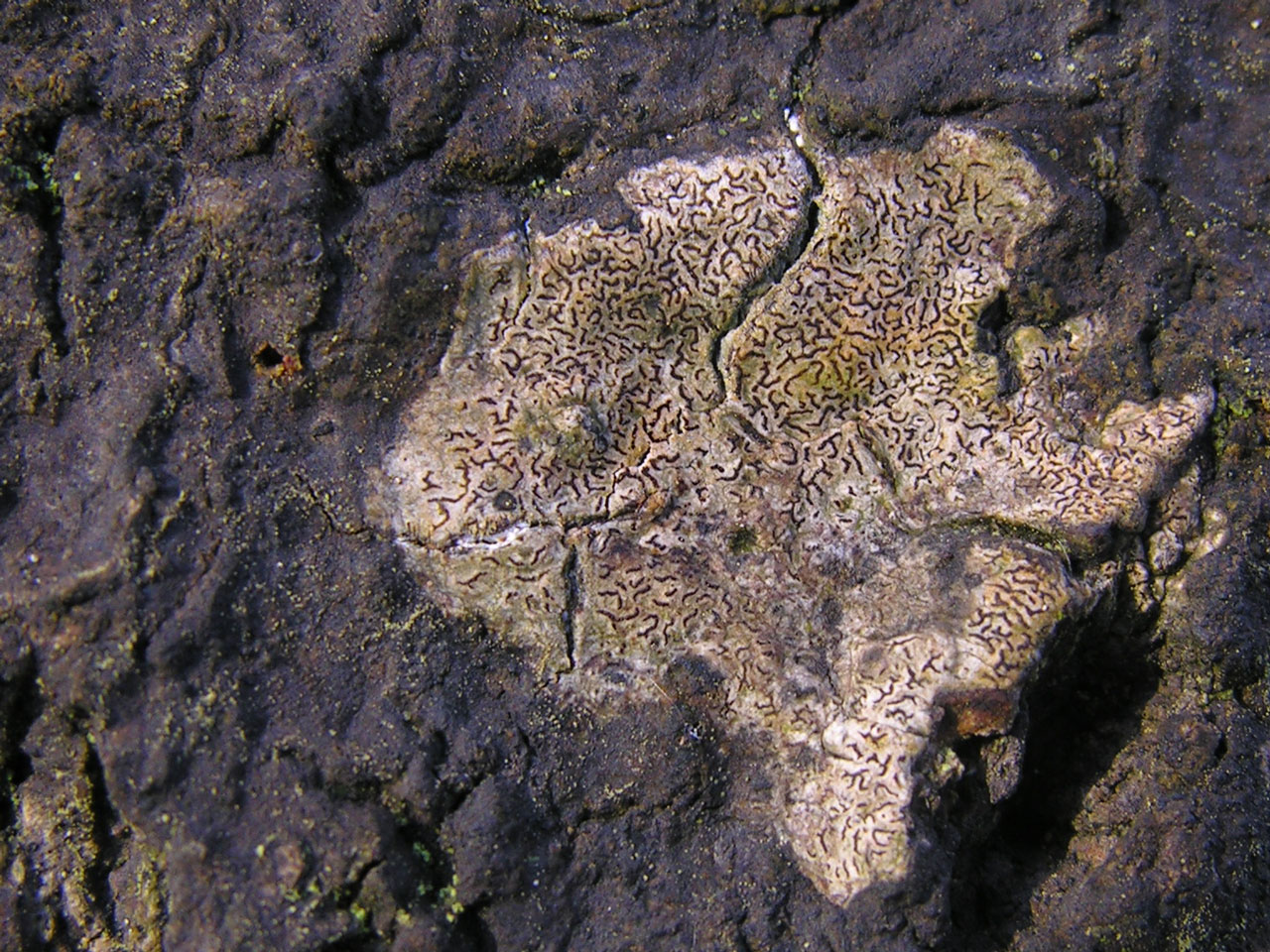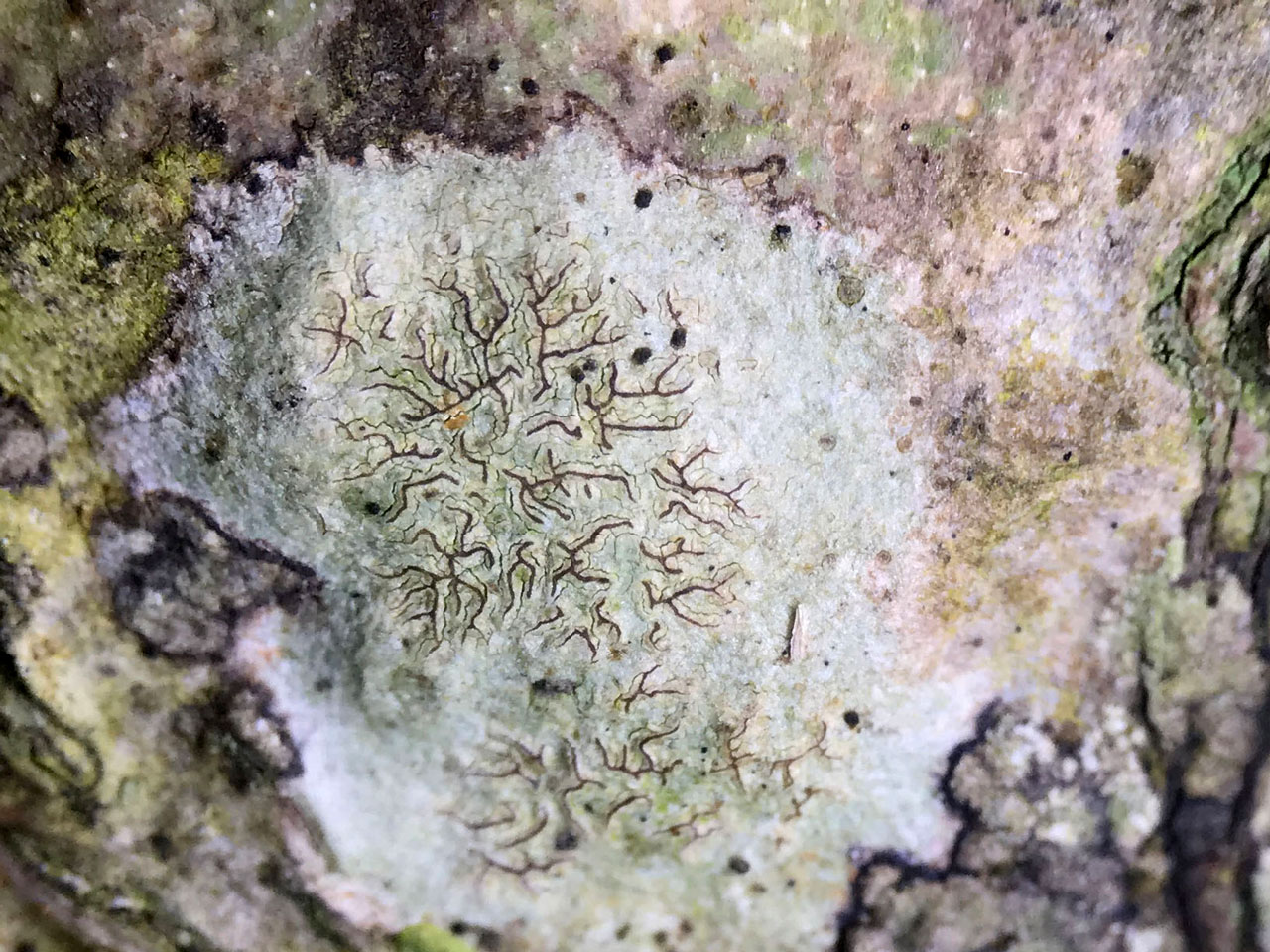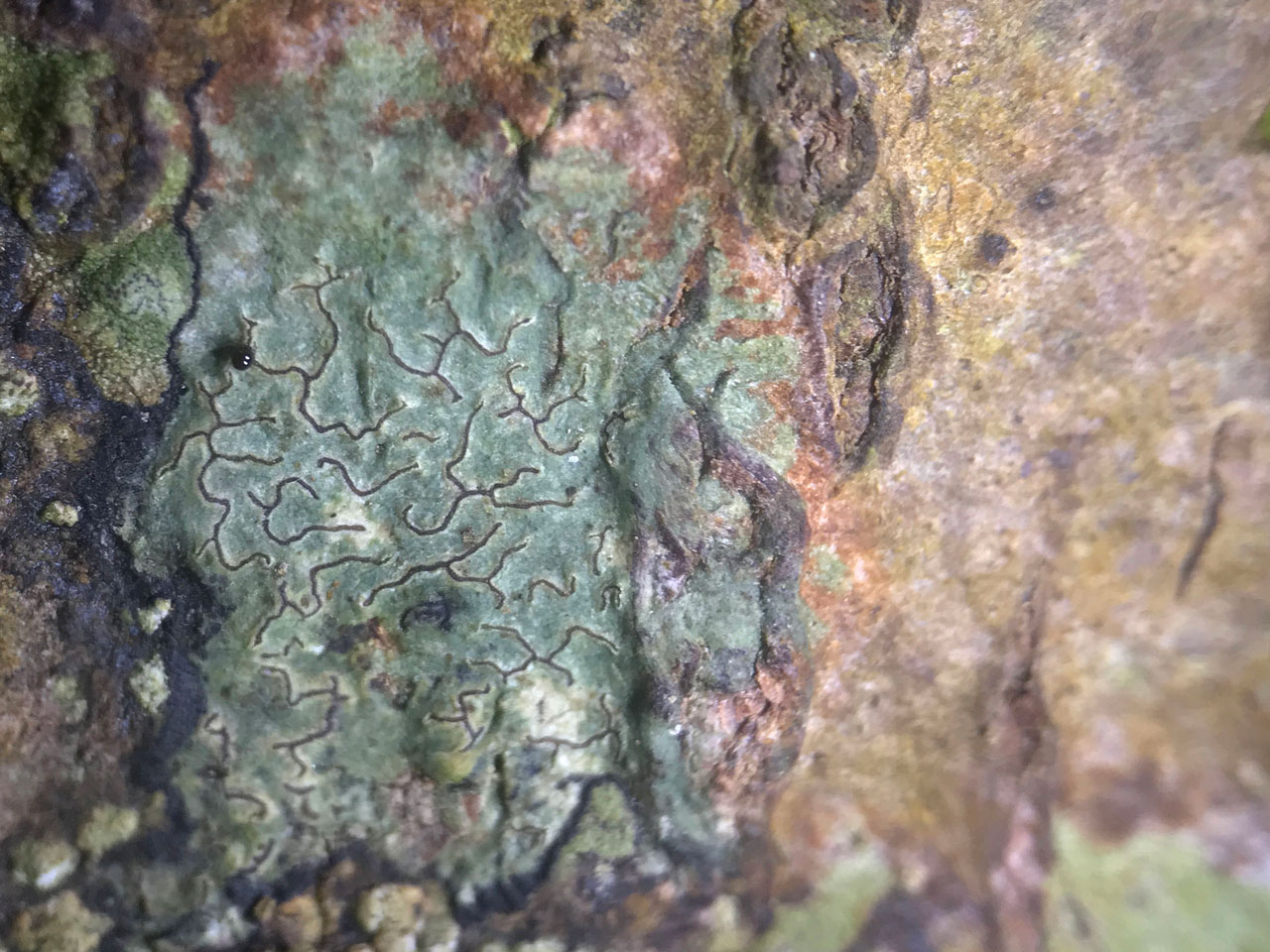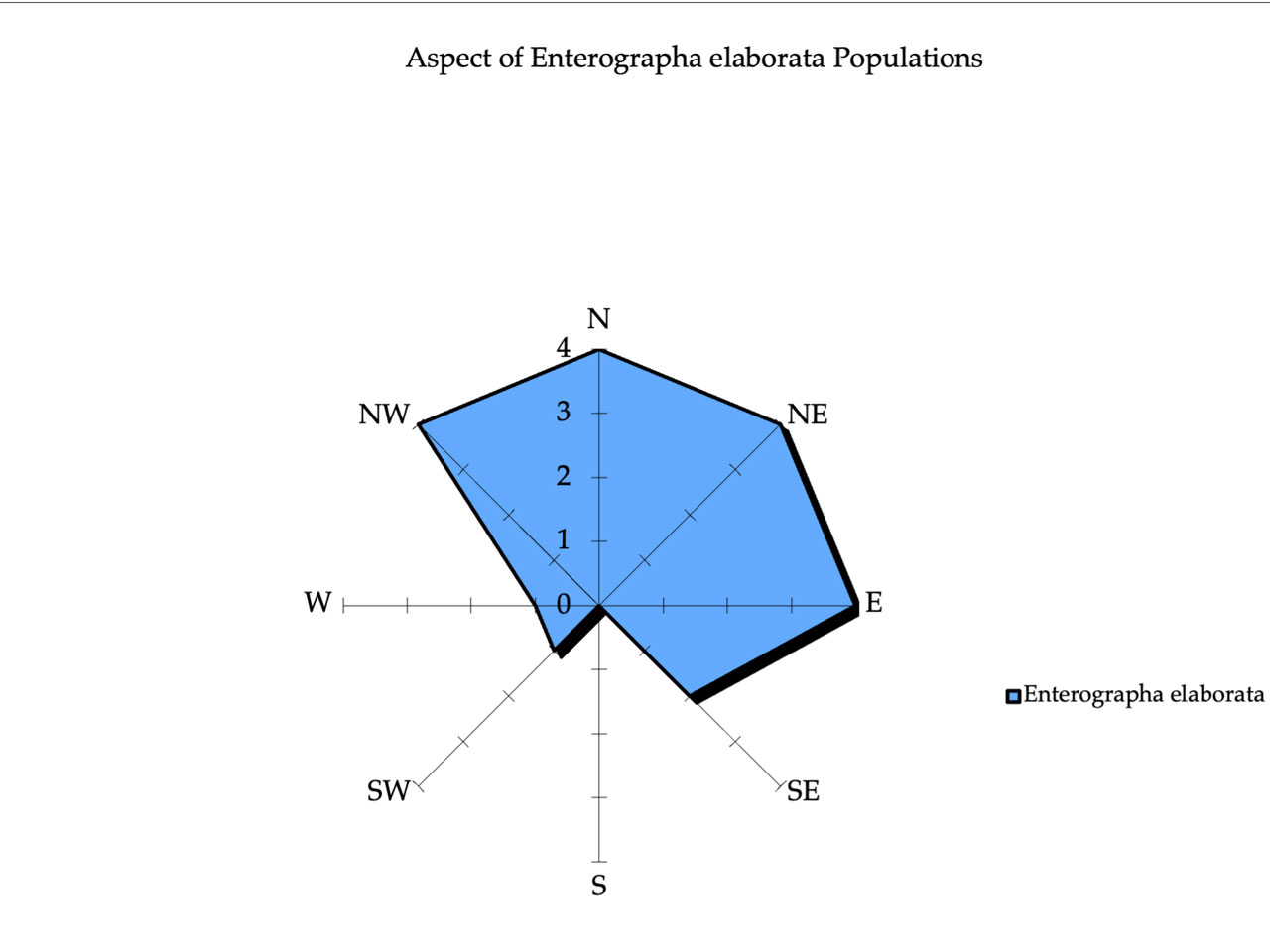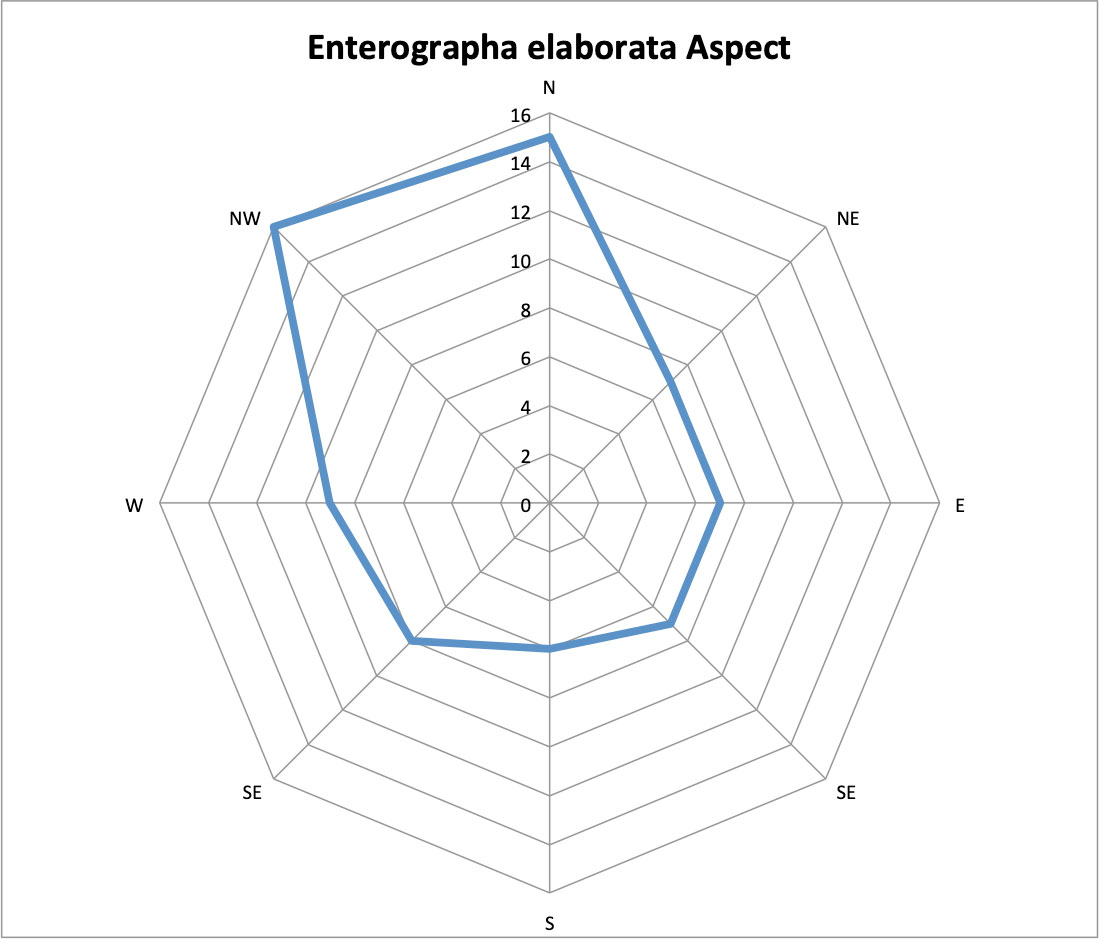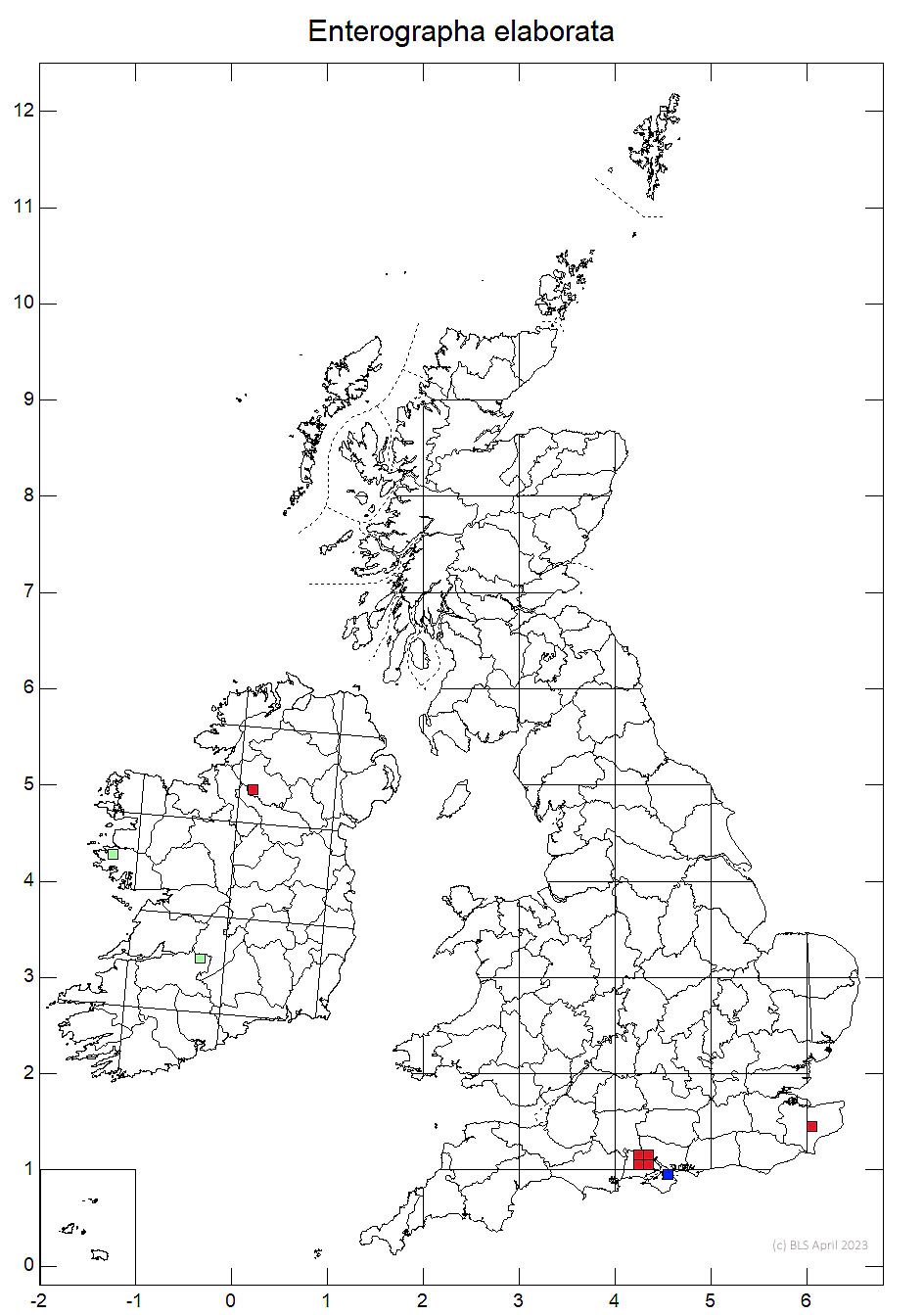Enterographa elaborata
An internationally rare lichen of humid southern temperate woodlands. Differs from the similar Enterographa crassa and E. hutchinsiae, with which it often grows, in the the Pd+ yellow reaction. However, given its rarity best separated visually by the distinctive very long angular lirellae; those of E. hutchinsiae are not as long and less forked or angular and those of E. crassa are short and dot like. Confined to rain tracks on veteran Beech, Hornbeam and Ash in Enterographa crassa – Pyrenula chlorospila/Pyrenula macrospora communities in old growth woodlands. It also largely avoids the south facing sides of trees, even in quite dense stands. Current known from two areas in southern England (New Forest, Hampshire & near Ashford, Kent) and a wood in Co. Fermanagh, Ireland, potentially over looked in other areas.
Like E. crassa but thallus pale pink – brown to pallid brown and in shade brownish green, densely granular- refractive, K+ dissolving; apothecia 0.2–2 (–5) mm × 0.08–0.15 mm long, extended, more conspicuous, serpentine, often branched or stellate; paraphyses 0.8–1 μm diam. Asci 8-spored. Ascospores 32–65 × 2.5–4.5 μm, 8- to 17-septate, often ± curved, with a thin epispore. Pycnidia very rare, dark brown, ca 0.1 mm diam.; conidia filiform, 12–17 × ca 0.7 μm. Thallus C± red, K– or faint yellow, Pd+ yellow-orange (psoromic, 2'-O-demethylpsoromic acids and minor amounts of gyrophoric acid). Gyrophoric acid is only present in the apothecial margins but the C+ red reaction is not easily visible in the field.
The Pd+ yellow-orange reaction readily separates it from E. crassa or E. hutchinsiae, while the very long angular lirellae are very distinctive once known. Those of E. hutchinsiae are not as long and less forked or angular.
Habitat similar to E. crassa, but on more flushed bark being strongly associated with rain tracks on the trunks with a reasonably high pH, but which are not constant wet. Always found with abundant Enterographa crassa and some Pyrenula chlorospila or Pyrenula macrospora. The associated species from Kent and the New Forest are listed below with constancy classes. In Fermanagh it was associated with dominant Enterographa crassa with Alyxoria varia, Enterographa hutchinsiae, Pertusaria hymenea and Pyrenula macrospora. Observations suggest it is among the first late succession colonisers of newly formed rain tracks or healing wound tracks. This allows it to colonise earlier than E. crassa, allowing it to form large thalli before before mass colonisation by the latter arriving E. crassa which forms many small thalli.
| Species | K | N |
|---|---|---|
| Enterographa elaborata | V | V |
| Enterographa crassa | V | V |
| Pyrenula chlorospila | V | V |
| Coniocarpon cinnabarinum | I | II |
| Opegrapha vulgata * | I | I |
| Phlyctis argena | I | I |
| Pertusaria hymenea | II | IV |
| Alyxoria varia * | II | |
| Lepraria finkii | II | |
| Metzgeria furcata | II | |
| Porina byssophila | II | |
| Bacidia phacodes * | I | |
| Caloplaca ulcerosa * | I | |
| Cliostomum griffithii | I | |
| Dactylospora parasitica | I | |
| Enterographa hutchinsiae | I | |
| Enterographa hutchinsiae | I | |
| Graphis scripta | I | |
| Isothecium myosuroides | I | |
| Lecanactis abietina | I | |
| Lecanora chlarotera s. lat. | I | |
| Lecanora expallens | I | |
| Opegrapha atra | I | |
| Opegrapha vermicellifera * | I | |
| Reichlingia zwackhii | I | |
| Strigula phaea | I | |
| Strigula sp A | I | |
| Strigula tagananae | I | |
| Strigula taylorii * | I | |
| Thelopsis corticola | I | |
| Thelotrema lepadinum | I | |
| Zygodon rupesteris | I | |
| Sporodophoron cretaceum | III | |
| Cresponea premnea | II | |
| Dendrographa decolorans | II | |
| Alyxoria culmigena | I | |
| Bacidia biatorina | I | |
| Lecanora argentata | I | |
| Pyrrhospora quernea | I | |
| Zwackhia prosodea | I | |
| Number Species | 15 | 32 |
* = Pioneer species in wound track communities in New Forest, K = Kent & N = New Forest
Enterographa elaborata is a woodland species that requires good indirect light and is absent from deeply shaded stands but conspicuously avoids southern aspects on trees, even in dense woodland. It requires veteran trees with complex trunk architectures that allow rain tracks to form. In the New Forest it is mainly dependent of naturally damaged, leaning or twisted veteran Beeches, which are found at a much lower density than the actively pollarded Hornbeams at the Kent site.

Very rare, Hampshire, New Forest on Beech, Kent, Hatch Park on Hornbeam, N. Ireland (Fermanagh) on Ash. Rediscovered in the Britain and Ireland in the 1990s, formerly also recorded from Isle of Wight & S.W. Ireland (Limerick). It could potentially occur more widely on old Ash in the west.
Enterographa elaborata is an internationally rare lichen of humid southern temperate woodlands found in scattered locations in western Europe from Denmark and Ireland to Iberia, Macaronesia, relic humid ravine sites by the Mediterranean and warm temperate rainforests by the Black Sea. There are three extant sites in Britain and Ireland. In Fermanagh, at Hanging Rock NNR, Sandy O’Dare discovered E. elaborata on one Ash tree and in 2009 it was found on three Ash trees by Neil Sanderson, none of which appeared to be the 1990 tree. In the New Forest in 2009, it was estimated from sampling as occurring on over 60 Beech trees (Sanderson, 2009) and since then active colonisation of new trees as well as the loss of old trees has been observed here. It has been recorded in nine separate woods in the New Forest. The most recent discovery was in a remarkable actively pollarded Hornbeam pasture woodland in East Kent by Hatch Park. Here E. elaborata was first discovered in 2014, during a visit by the British Lichen Society (Palmer & Blatchley, 2015). Sanderson (2021) recorded it in on 163 trees, all Hornbeam and all but five being actively cut pollards, the others being younger maiden trees. Active colonisation of new trees was also clearly occurring here. The density is remarkable and appears exceptional in a world context, no other reports of the species at anything like this density was found by Sanderson (2009) anywhere within the lichen’s range.
The Fermanagh site is threatened by increasing shaded and only wild goat browsing was keeping the trees open enough in 2009. The New Forest sites are reasonably secure. Shade from Holly is a potential threat here, but an active programme of Holly pollarding is containing this (Sanderson, 2019). The remarkable Kent site needs the pollarding maintained and grazing reintroduced and Plantlife have been working with the owners to secure the future of the site.
Britain: Critically Endangered, International Responsibility Species
England: Section 41 species
Northern Ireland: Biodiversity Action Plan Species
Cannon, P., Aptroot, A., Coppins, B., Ertz, D., Sanderson, N., Simkin, J. & Wolseley, P. (2021). Arthoniales: Roccellaceae, including the genera Cresponea, Dendrographa, Dirina, Enterographa, Gyrographa, Lecanactis, Pseudoschismatomma, Psoronactis, Roccella, Schismatomma and Syncesia. Revisions of British and Irish Lichens 16: 1-22.
Palmer, K. & Blatchley, I. (2015) British Lichen Society Autumn Meeting 2014 Kent (based at Lenham): 16th-20th October, 2014. British Lichen Society Bulletin 116: 100-122.
Sanderson, N. A. (2009) A Species Dossier for Fancy Writing Enterographa elaborata in Britain. A report by Botanical Survey & Assessment to Natural England.
Sanderson, N. A. (2019) New Forest Holly Management and Epiphytic Lichen Conservation 2019. A Botanical Survey & Assessment report to Natural England, Forestry Commission & National Trust.
Sanderson, N. A. (2021) Lichen Survey of Brockhanger Wood & Part of Hatch Park, Kent 2021. A report by Botanical Survey & Assessment to Plantlife.
Text by Neil A. Sanderson based on Cannon et al (2021)
